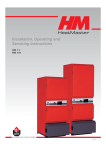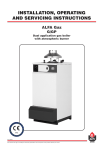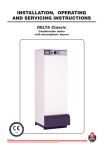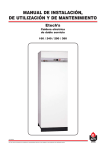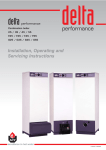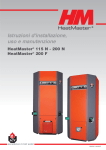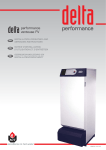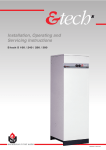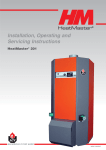Download ACV 60 N User guide
Transcript
HeatMaster Installation, Operating and Servicing Instructions HM 60 N / 70 N / 100 N / 150 JUMBO HM 60 N / 70 N / 100 N With ACV BG 2000-S premix gas burner HM 60 N / 70 N / 100 N With ACV BM 101 oil burner HM 150 JUMBO With ACV BM 151 oil burner excellence in hot water 66400501 INDEX INTRODUCTION INTRODUCTION 1 INTENDED USERS OF THESE INSTRUCTIONS Intended users of these instructions Symbols Applicable standards Warnings 1 1 1 1 These instructions are intended for - specifying engineers - installing engineers - end-users - servicing engineers DESCRIPTION 2 Operating principle Construction features 2 2 TECHNICAL SPECIFICATION 5 Essential instruction for operating the system correctly. Maximum operating conditions Burner chamber plate Domestic hot water performances General features Dimensions 5 5 5 5 6 Essential instruction for personal safety or environmental protection. INSTALLATION 8 Danger of electrocution. SYMBOLS Boiler room Chimney connections Hot water connections Heating connection Oil supply connections Electrical connections Wiring diagram 8 8 10 11 11 12 12 COMMISSIONING 14 Filling the hot water and heating circuits 14 BURNER FEATURES 15 ACV BG 2000-S premix gas burners ACV BM 101 and BM 151 oil burners 15 19 MAINTENANCE 20 Service intervals Servicing the boiler Servicing the safety devices Servicing the burner Draining the boiler Spare parts 20 20 21 21 21 21 USER GUIDE 22 Using the boiler Boiler safety shutdown Resetting the oil burner Resetting the BG 2000-S premix burner Burner troubleshooting 22 23 23 23 23 SERVICE RECORD 24 The following symbols are used in these instructions: Risk of scalding. APPLICABLE STANDARDS The products have received the “CE” certificate in accordance with the standards prevailing in different countries (European Directives 92/42/EEC, “efficiency”, 90/396/EEC “gas appliances”). These products have also received the Belgian “HR+” (gas boilers) marks and “OPTIMAZ” (oil boilers) marks. WARNINGS These instructions are an integral part of the equipment to which they refer and must be supplied to the user. The product must be installed and serviced by qualified engineers, in compliance with the prevailing standards. ACV accepts no liability for any damage resulting from incorrect installation or from the use of components or fittings not specified by ACV. Failure to observe instructions regarding tests and test procedures can result in personal injury or pollution risks. Note: ACV reserves the right to modify the technical specifications and components of its products without prior notice. 1 DESCRIPTION OPERATING PRINCIPLE CONSTRUCTION FEATURES The HeatMaster is a high performance, direct fired hot water storage heater, which has indirect heat transfer due to its Tank-in-Tank construction. Outer body At the heart of the HeatMaster is a stainless steel cylinder through which the flue tubes pass. This is surrounded by a mild steel shell containing the primary water (neutral fluid). The outer shell extends down to the combustion chamber and even around the flue tubes. The area of the heat transfer surface is therefore much greater than that of standard direct fired water heaters. TANK-IN-TANK heat exchanger A circulating pump fitted to the primary circuit moves the water around the tank, heating it faster and maintaining an even temperature across the primary jacket. Combustion gas circuit The outer body containing the primary fluid is made of thick STW 22 steel. The ring-shaped inner tank with its large heating surface for producing domestic hot water is built of Chrome/Nickel 18/10 stainless steel. It is corrugated over its full height by an exclusive production process and entirely argon arc welded by the TIG (Tungsten Inert Gas) method. The combustion gas circuit is paint-protected and comprises: The burner, either gas or oil, fires onto the primary water which indirectly heats the stainless steel cylinder containing the DHW. As with all Tank-in-Tanks, this is corrugated over its full height and suspended in the HeatMaster by its hot and cold water connections. • Flue pipes Depending on output, HeatMaster models contain several steel flue pipes with an internal diameter of 64 mm. Each pipe is fitted with a baffle of special steel designed to improve heat exchange and reduce flue gas temperature. The cylinder expands and contracts during use and this, together with the fact that cold water does not come into contact with the intense heat of the burner flame, means that limescale buildup is prevented. • Combustion chamber The combustion chamber on HeatMaster models is entirely water cooled. This scale resistant feature, along with the corrosion resistance of stainless steel, eliminates the need for sacrifical anodes. The HeatMaster has one very major advantage over other direct fired water heaters - because it heats the DHW with a primary circuit, this primary water can be used to provide central heating as well. By connecting two, three, four or more HeatMasters together in a module, most hot water and heating demands can be met. Indeed, when used in conjunction with HR and Jumbo hot water storage tanks the Heatmaster can supply even the largest hot water requirement. Standard equipment The HeatMaster 60 N / 70 N / 100 N and 150 Jumbo has the following items as standard : - On/off switch - Summer/Winter switch - Timeclock - primary circulating shunt pump - primary expansion vessels - primary safety valve - pressure and temperature gauge - drain valve - body completely insulated in rigid polyurethane foam 2 Insulation The boiler body is fully insulated by rigid polyurethane foam with a high thermal insulation coefficient, sprayed on without the use of CFCs. Casing The boiler is covered by a steel jacket which has been scoured and phosphated before being stove enamelled at 220 °C. The jacket of the HM 150 Jumbo is delivered separately and must be assembled on site following the instructions supplied with it. Burner All HeatMaster models can be fitted with pressure jet gas burners or oil burners. The HeatMaster 60, 70 and 100 can also be fitted with the low-NOx pre-mix BG 2000 gas burner. DESCRIPTION Features of HeatMaster 70 N / 100 N Flue reduction collar Top cover Central heating flow pipe Automatic air vent Domestic hot water outlet Domestic cold water inlet Flue pipes and turbulators Heating circuit filling valve with removable hose and non-return valve Tank-in-Tank heat exchanger Primary expansion vessel Insulation Primary shunt pump Burner Casing front panel Heating return Primary circuit Combustion chamber Burner chamber plate Safety features of the HeatMaster 60 N Control panel HeatMaster 60 N Thermal reset high limit thermostat Combined temperature and pressure gauge Manual reset high limit thermostat Manual reset high limit thermostat Burner lockout indicator Time clock Low water pressure switch I O Primary safety valve Primary circuit low water pressure indicator Control thermostat ON / OFF switch Control thermostat High limit cutoff indicator Summer / Winter switch 3 DESCRIPTION Safety features of the HeatMaster 70 N and 100 N Control panel HeatMaster 70 N and HeatMaster 100 N Thermal reset high limit thermostat Combined temperature and pressure gauge Manual reset high limit thermostat Manual reset high limit thermostat Burner lockout indicator Summer / Winter switch Time clock Low water pressure switch I O Control thermostat Primary circuit low water pressure indicator ON / OFF switch Control thermostat High limit cutoff indicator Primary safety valve Safety features of the HeatMaster 150 Jumbo Control panel HeatMaster 150 Jumbo Primary safety valve Mains power electrical connection (multi-pin plug) Thermal reset high limit thermostat Combined temperature and pressure gauge bar ..... Relay base ..... ..... Manual reset high limit thermostat Primary circuit low water pressure indicator ... 18 19 17 20 16 21 22 14 23 I 11 1 12 24 13 Time clock 15 2 O 10 9 3 GRASSLIN 4 8 7 6 5 Low water pressure switch ON / OFF switch Fuse Manual reset high limit thermostat Control thermostat Thermal reset high limit thermostat Servicing socket Control thermostat 4 (230 V ˜ 50 Hz) TECHNICAL SPECIFICATION MAXIMUM OPERATING CONDITIONS BURNER CHAMBER PLATE Maximum service pressure (tank full of water) - Primary circuit: 3 bar - Secondary circuit: 10 bar The burner chamber plate has 4 threads (M 10 x 20) for attaching the burner. It is protected from heat by a blanket insulation. Test pressure (tank full of water) - Primary circuit: 4.5 bar - Secondary circuit: 13 bar 5xØ6.5(M8) Operating temperature - Maximum temperature: 90 °C Ø130 Ø28 60 Water quality • Chlorures: < 150 mg/l (304) < 2000 mg/l (Duplex) 60 60 60 • 6 ≤ ph ≥ 8 DOMESTIC HOT WATER PERFORMANCES HM 60 N HM 60 N HM 70 N HM 70 N HM 100 N HM 100 N HM 150 BM 101 BG 2000-S/60 BM 101 BG 2000-S/70 BM 101 BG 2000-S/100 JUMBO Peak Peak Peak Peak Peak delivery delivery delivery delivery delivery at at at at at 40 45 60 70 80 °C °C °C °C °C L/10’ L/10’ L/10’ L/10’ L/10’ 474 378 245 193 135 474 378 245 193 135 646 543 346 268 207 646 543 346 268 207 905 777 514 343 258 905 777 514 343 258 1504 1289 870 700 540 Peak Peak Peak Peak Peak delivery delivery delivery delivery delivery at at at at at 40 45 60 70 80 °C °C °C °C °C L/60’ L/60’ L/60’ L/60’ L/60’ 1942 1656 1106 681 499 1942 1656 1106 681 499 2133 1794 1219 971 636 2133 1794 1219 971 636 3172 2680 1813 1226 893 3172 2680 1813 1226 893 4828 4138 2864 2131 1362 delivery delivery delivery delivery delivery at at at at at L/h L/h L/h L/h L/h 1835 1573 1101 791 455 1835 1573 1101 791 455 1835 1573 1067 918 580 1835 1573 1067 918 580 2776 2379 1665 1104 804 2776 2379 1665 1104 804 3989 3419 2393 1718 987 min 9 9 16 16 13 13 17 Continuous Continuous Continuous Continuous Continuous 40 45 60 70 80 °C °C °C °C °C Reheat time at 60 °C GENERAL FEATURES HM 60 N HM 70 N HM 100 N HM 150 JUMBO Maximum Input Maximum Output Maintenance loss at 60 °C as rated value Total capacity Primary circuit capacity Heating connection Hot water connection Hot water tank heat exchange surface Weight empty Pressure drop primary circuit kW kW % L L Ø Ø m2 Kg mbar 69.9 62.5 0.57 162 82 11/2” 3/4” 2.46 220 54 69.9 63.0 0.60 239 108 11/2” 1” 3.14 270 46 107.0 96.8 0.65 330 130 11/2” 1” 3.95 320 83 154.0 139.1 0.52 645 245 DN 50 2” 5.30 530 120 5 TECHNICAL SPECIFICATION DIMENSIONS The units are delivered fully assembled, tested and packed on a timber base with shockproof edges and protected by heat-shrunk plastic film. On reception and after unpacking, check the equipment for damage. For transport purposes, refer to the weight (page 5) and dimensions given below. A mm B mm C mm D mm E mm F mm G Ø mm H mm J mm K mm HM 60 N 1698 1583 538 625 540 390 150 1098 281 1665 HM 60 N BG 2000-S 60 1698 1583 538 801 540 390 150 1098 281 1665 HM 70 1743 1630 678 797 680 390 150 1289 285 1720 HM 70 N BG 2000-S 70 1743 1630 680 937 680 390 150 1289 285 1720 HM 100 N 2093 2030 680 797 680 390 150 1693 285 2120 HM 100 N BG 2000-S 100 2093 2030 680 937 680 390 150 1693 285 2120 HM 150 Jumbo 2124 2117 1020 1440 1020 600 250 1383 590 2250 HeatMaster 60 N Without burner With ACV BG 2000-S premix gas burner F G A A B H K C/2 J C D 6 C D E TECHNICAL SPECIFICATION HeatMaster 70 N and HeatMaster 100 N Without burner G With ACV BG 2000-S premix gas burner A F A H B K C/2 J C C D E D HeatMaster 150 Jumbo F A 562 H K C D G J E 7 INSTALLATION BOILER ROOM CHIMNEY CONNECTIONS Important • • • Keep vents free at all times. Do not store inflammable products in the boiler room. Do not store corrosive products near the boiler, such as paints, solvents, chlorine, salt, soap and other cleaning products. If you smell gas, do not switch on the light or light a flame. Turn off the mains gas tap at the meter and inform the appropriate services immediately. • IMPORTANT Boilers must be installed by an approved heating engineer, in accordance with the prevailing local standards and regulations. Access Flue size should not be less then the outlet size of the boiler. The boiler room must be large enough to allow good access to the boiler. The following minimum distances are required around the boiler: - front side behind above 500 100 150 700 mm mm mm mm Chimney connection type: B23 The boiler is connected to the chimney by a metal pipe rising at an angle from the boiler to the chimney. A flue disconnection piece is required. This must be easy to remove to give access to the flue pipes when servicing the boiler. Ventilation The boiler room must be fitted with top and bottom vents sized according to the table below or to current regulations. The table below gives an example conforming to the Belgian standards. Ventilation 60 N 70 N 100 N 150 A. B. C. D. E. F. Top vent Bottom vent Draught regulator Inspection window Height of lined chimney Chimney diameter F Jumbo E Min. fresh air requirement m3/h 126 126 194 Bottom dm2 2.11 2.11 3.20 278 4.8 Top dm2 2.0 2.0 2.0 2.0 C A Other countries should refer to their own standards. B Base D The base on which the boiler rests must be made of non-combustible materials. Chimney minimum flue diameter 60 N E = 5 m Ø F min. mm E = 10 m Ø F min. mm E = 15 m Ø F min. mm 189 159 150 70 N 100 N 150 Jumbo 189 159 150 234 178 150 286 250 250 Note: Regulations vary from country to country therefore the table above is intended only as a guide. Due to the high efficiency of our boilers, the flue gasses exit at low temperature. Accordingly, there is risk that the flue gasses could condense, which could damage the chimney. In order to avoid this risk, it is strongly recommended that the chimney be lined. 8 INSTALLATION Balanced flue boiler connection type: C C33 120 C13 150 min. C13: concentric horizontal connection C33: concentric vetical connection C53: parallel chimney connection C63: concentric vertical connection without terminal (only in Germany and Luxembourg). C53 2 m min. • • • • Maximum length concentric : 6 metres Maximum length parallel : 12 metres Note: a 90 degree bend = 1 metre equivalent length A condensation drain outlet must be fitted close to the boiler to prevent condensation products from the chimney running into the boiler. To avoid condensation water running out of the terminal, all horizontal flue runs must fall back towards the boiler. 9 INSTALLATION HOT WATER CONNECTIONS Example of parallel connection Recommended for applications with a high continuous flow. Pressure reducing valve If the mains water pressure is greater than 6 bar, a pressure reducing valve must be fitted. Expansion relief valve The tank expansion relief valve must be ACV approved and calibrated to a maximum of 7 bar. The valve discharge must be connected to the drain. Hot water expansion vessel A hot water expansion vessel must be installed. Hot water circulation I I O I O O If the tank is situated a long way from the point of use, then installing a recirculation loop can provide a faster supply of hot water to the outlets. Temperature and pressure relief valve If using the HeatMaster as an unvented hot water unit, in some countries, a temperature and pressure relief valve must be fitted - consult your ACV stockist for assistance. Example of hot water connection with thermostatic mixer 1. Stop cock 2. Non-return valve 3. Pressure reducing valve 4. Expansion relief valve 5. Hot water expansion vessel 6. Hot water secondary pump (it fitted) 7. Thermostatic mixing valve 8. Drawoff tap 9. Drain cock 10. Stop cock for cleaning 11. Temperature relief valve (UK-only) Example of series connection Preferable for high temperature applications with up to three units. 2 1 2 6 8 3 I O 7 4 I I O O 10 11 5 Example of heating + storage connection Recommended for applications requiring a high peak flow. I O 9 I O DANGER! As a safety measure against scalding, we strongly recommend installing a thermostatic mixing valve. 10 INSTALLATION HEATING CONNECTION OIL SUPPLY CONNECTIONS - ACV BM BURNERS The HeatMaster has two connections at the rear that can be used to connect a central heating circuit. Connecting a heating system may reduce the domestic hot water performance. (If another make of buner is fitted please refer to that manufacturers technical manual) Installation without return Expansion max 4m The HM 60 is fitted with an 8 litre expansion vessel. HM 70/100 models are fitted with two 10 litre expansion vessels, and the HM 150 Jumbo is fitted with four 8 litre expansion vessels. These expansion vessels are sized for hot water operation only. If a heating system is connected to the primary circuit, calculate the expansion capacity necessary for the total volume of the heating system. (Refer to the technical instructions from a relevant manufacturer of expansion vessels). Example of a single circuit connection H 3-way valve Heating pump Non-return valve Isolating valves Safety valve set to 3 bar with pressure gauge Expansion vessel Drain cock Controller L1 L (m) 8 1 2 4 3 (L = H + L1) H (m) Ø int. 8 mm Ø int. 10 mm 0.5 10 20 1 20 40 1.5 40 80 2 60 100 Installation with return I O 5 L1 6 4 H 7 max 4m 1. 2. 3. 4. 5. 6. 7. 8. WARNING The pimary safety valve is supplied with a plastic tube connected to the discharge outlet - this is for test purposes only and should be removed. The safety valve should be connected to a drain using a metallic pipe eg. copper. H L1 L (m) (L = H + L1) H (m) Ø int. 8 mm Ø int. 10 mm 0 35 100 0.5 30 100 1 25 100 1.5 20 90 2 15 70 2 8 30 3.5 6 20 11 INSTALLATION ELECTRICAL CONNECTIONS WIRING DIAGRAM Power supply HeatMaster wiring diagram legend 60 N, 70 N, 100 N (page 13) and 150 Jumbo (page 14) The boiler operates with a 230 V - 50 Hz single phase supply. A double pole isolator with a 6 amp fuse or a 6 amp MCB must be fitted outside the boiler to allow power to be shut off during servicing and before any repairs are carried out on the boiler. 1. 2. 3. 4. 5. 6. 7. 8. 9. 10. 11. 12. 13. 14. 15. 16. 17. 18. 19. Conformity Boiler installation must comply with the prevailing local standards and legislation. Safety The stainless steel tank must be earthed separately. The power to the boiler must be switched off before any work is carried out. 230 V power connection plug On/off switch Temperature high limit cutoff indicator (except HM 150 Jumbo) Manual reset high limit thermostat Primary circuit low water pressure indicator Low water pressure switch Time clock Summer/winter switch (except HM 150 Jumbo) Hot water priority link (except HM 150 Jumbo) Burner lockout indicator (except HM 150 Jumbo) Room thermostat connection (option) Central heating pump HeatMaster shunt pump Burner plug connector Water flow switch connection (option) Thermal reset high limit thermostat 95 °C Control thermostat 230 V servicing socket (only HM 150 Jumbo) Relay (only HM 150 Jumbo) Electrical connection HeatMaster 60 N, 70 N and 100 N N T1 T2 S3 B4 L1 N T1 T2 S3 B4 Y G Gr 13 Y Or 15 G B Br Y/Gr 12 11 B Br 14 Gr L1 Y/Gr Blue Black Brown Grey Green Orange Pink Red Violet White Yellow Yellow / Green Y/Gr B B Pk 9 W 1 Or B Or Y/Gr G 10 2 C 8 Or B Or Or B Or B 5 Pk 4 7 95 °C 1 16 Bk Br 3 2 C B 2 Bk 1 C 5 103 °C 0 - 90 °C B B Y/Gr Br W 6 G 4 1 3 2 17 P 1 2 C W B B Or B B I 2 O Br B Br Y/Gr B L1 N L1 N 1 12 W Bk W R B Pk G B G Y/Gr Pk 1 2 3 4 5 6 7 8 9 10 11 12 13 14 15 16 17 18 19 20 Y/Gr G B. Bk. Br. G. Gr. Or. Pk. R. V. W. Y. Y/Gr. INSTALLATION Electrical connection HeatMaster 150 Jumbo Pk. R. V. W. Y. Y/Gr. Pink Red Violet White Yellow Yellow / Green W Blue Black Brown Grey Green Orange W W Br 6 11 A1 1 4 5 9 A2 B W 1 C 10 - 100 °C 2 W 1 C R Br Br 17 Br B Bk 95 °C 16 B B A1 Br Or Bk W 19 G B A2 Br W Br Br Bk Pk W Bk 1 3 5 5 Bk 7 R 4 4 B Or B Bk 2 C B 103 °C W B Or V Or 2 1 2 1 6 2 R R B C B Br B Bk Br Y/Gr B Or Y/Gr Or B 6,3 A B W Bk B Or B Y/Gr Br 1 R Br Br ph B ~ 11 n Br B B N T1 T2 S3 B4 N T1 T2 S3 220/240V 50 Hz Br Br Bk Bk B Br 14 L1 Y/Gr Y/Gr 15 L1 Y/Gr B W B 1 2 3 4 5 6 7 8 9 10 11 12 13 14 15 16 17 18 19 20 Y/Gr R W Or R B Bk G Pk W V W B R B Bk B Br 18 Br W B. Bk. Br. G. Gr. Or. 230V signal connections 13 12 Boiler run High temperature Burner lock out 13 COMMISSIONING FILLING THE HOT WATER AND HEATING CIRCUITS HeatMaster 70 N and 100 N C IMPORTANT Hot water tank must be pressurised before the heating circuit is filled. B 1. Close the primary circuit filling valves (A) 2. Open the stop valve (B) and the drawoff tap (C). When water flows out of the tap, the hot water tank is full and the drawoff tap (C) should be closed. 3. Fill the primary (heating) circuit by opening the valves (A) and pressurising to 1 bar. 4. Open the automatic air vent located on top of the boiler. A IMPORTANT - the screw cap must be left loose to allow future automatic venting to take place. 5. After venting the air from the system, bring the pressure up to the static head plus 0.5 bar: 1.5 bar = 10m and 2 bar = 15 m. 6. Check that the electrical connection and boiler room ventilation conform to the relevant standards. 7. Set the thermostat between 60 and 90 °C. 8. Switch the on/off switch to the ON position. 9. For gas burner, check the gas supply pressure on starting up. 10. For the oil burner, check the oil supply (and return). Proceed with the necessary venting, measurements and settings. 11. Set the heating control to heat demand. When the burner operates, check the flue gas discharge pipes for leaks. 12. After 5 minutes of operation, vent the primary circuit again maintaining the water pressure at 1 bar. 13. Then restart the unit and check the combustion. I O HeatMaster 60 N HeatMaster 150 Jumbo C C B B I O A umbo Kerkplein 39 1601 Sint-Pieters-Leeuw(Ruisbroek) Belgium Num. Code Typ. Anno Max. Temp. Chauffage-CV-Heizung Eau sanitair. water-Brauchwasser bar Débit-Debiet-Abflussmenge .. .... ... Agréation-Keuring-Prüfnummer . .. . . .. .. 18 19 17 16 20 21 15 22 14 I 11 1 12 24 23 13 10 2 O 3 4 8 7 6 5 14 9 GRASSLIN A BURNER FEATURES ACV BG 2000-S PREMIX GAS BURNERS ACV BG 2000-S premix gas burners dimensions Description The burner tube is coated with metal fibre (NIT) which, in addition to its remarkable heat exchange capabilities, gives greater durability. The main components are a venturi and one (model 60 and 70) or two (model 100) gas valves, technology specially developed by Honeywell for low Nox premix air/gas burners with automatic ignition and ionisation flame detection. The pressure at the gas valve outlet is equal to the air pressure in the neck of the venturi, less the offset. The fan sucks combustion air through the venturi, into which the gas inlet emerges. As it passes through, the air produces a pressure differential in the constriction of the venturi and sucks the gas into the venturi outlet. A perfect mix of air and gas then passes through the fan to the burner tube. Type BG 2000-S / 60 BG 2000-S / 70 BG 2000-S / 100 A A B C 375 375 375 228 248 248 248 342 342 B This design ensures very quiet and safe operation: • If there is an air blockage, the pressure differential in the venturi falls, the gas flow diminshes, the flame goes out and the gas valve closes: the burner is in safety shutdown mode. • If there is a blockage in the chimney outlet, the air flow diminishes, and the same reactions as those described above cause the burner to shut down in safety mode. • The BG 2000-S burner fitted to the HeatMaster 60, 70 and 100 is controlled by a Honeywell module which controls burner operating safety. C BG 2000-S burners are preset at the factory for natural gas. Conversion to propane: Not applicable for Belgium. Conversion kit included with burner comprising: - Cap(s) - Nameplate(s) - Sticker with settings. - Mounting instructions. Air-gas mixture control system Venturi Fan Air - gas mixture Air Offset regulation screw Gas Gas flow regulating screw 15 BURNER FEATURES Burner electrical connection BG 2000-S/60 and BG 2000-S/70 Electrical connections L1 G Br Y/Gr Gr Bk Y G B Gr Y/Gr B Br Y/Gr Y Br Bk B B Br N T1 T2 S3 B4 Br Blue Black Brown Grey Green Yellow Yellow / Green Br B. Bk. Br. G. Gr. Y. Y/Gr. 1 2 3 4 5 6 7 8 9 10 11 12 L1 N Burner electrical connection BG 2000-S/100 Electrical connections L1 Br Bk Br B Br N T1 T2 S3 B4 B Blue Black Brown Grey Green Yellow Yellow / Green Br B. Bk. Br. G. Gr. Y. Y/Gr. B L1 N 16 1 2 3 4 5 6 7 8 9 10 11 12 Br B Y/Gr G Y Br Bk Y G B Gr B Br Y/Gr Y/Gr Gr Br BURNER FEATURES ACV premix gas burner BG 2000-S/60 and BG 2000-S/70 Ignition electrode Burner chamber plate insulation Burner tube Gas valve Venturi Chamber plate Fan Ionisation probe Potentiometer setting Relay Gas inlet Burner plug connector Fan power plug ACV premix gas burner BG 2000-S/100 Ignition electrode Burner chamber plate insulation Burner tube Gas valve Venturi Chamber plate Fan Potentiometer setting Ionisation probe Relay Gas inlet Fan power plug Burner plug connector 17 BURNER FEATURES HeatMaster 60, 70 and 100 Gas burner features - BG 2000 Input Output Combustion efficiency - natural gas Natural gas CO2 HM 60 N HM 70 N HM 100 N HM 100 N HM 150 Jumbo + BG 2000-S/60 + BG 2000-S/70 + BG 2000-S/100 + gas pressure jet burner + gas pressure jet burner 69.9 63.0 91.2 9.5 69.9 63.0 91.5 9.0 85.0 77.4 92.9 9.0 96.8 90.0 92.9 9.0 154 139.1 91.5 9.0 m3/h 7.40 7.40 8.99 10.24 16.30 m3/h 8.60 8.60 10.46 11.91 18.95 m3/h 2.86 2.86 3.47 3.95 6.29 mbar °C 0.6 186 0.6 172 1.4 145 1.4 165 0.6 181 32.1 32.1 39.1 44.5 70.8 kW kW % % Gas G20 - 20 mbar - I 2E(S)B - I 2 Er - I 2H Flow Gas G25 - 20/25 mbar - I 2L - I 2ELL Flow Gas G31 - 37/50 mbar - I 3P Flow Pressure drop combustion chamber Flue gas temperature (net) Mass rate of combustion products (grammes per second) Gas category BE I I I I I I 18 2Er 2E(S)B 2H 3P 2L 2ELL FR AT DK ES UK IT PT IE SE NL LU DE BURNER FEATURES ACV BM 101 AND BM 151 OIL BURNERS Features - Description - The use of new technology enables our medium output burners to meet current performance and emissions quality requirements. These burners are fitted with high quality components including a two-stage oil pump that permits soft start. - Components: - Landis & Gyr relay - A.E.G. motor - Suntec pump - May & Christe transformer - Landis & Gyr oil preheater - Easy to install – fitted with safety closure and new burner suspension system. The burner air pressure adjusts to the pressure in the burner chamber. An automatic damper shuts off the air flow when the burner is turned off, preventing the boiler from cooling. Quiet and extremely reliable. Adjustable to the depth of the boiler burner chamber thanks to the adjustable bracket at the mouth of the burner chamber. Three air adjustment points to ensure the best air/oil mixture. • upstream air presetting • primary setting • combustion head setting Oil burner specification and perfomances Burner type Input Nozzle flow Nozzle angle Oil flow Pump pressure HM 60 N HM 70 N HM 100 N HM 150 JUMBO Kg/h bar BM 101 69.9 1.50 60° 5.9 10.5 BM 101 69.9 1.50 60° 5.9 10.5 BM 151 107.0 2.00 60° 8.92 13.5 BM 151 154.0 3.00 60° 13.0 12.5 mbar °C % 0.6 175 12.5 0.6 170 12.5 1.4 170 12.5 0.6 181 12.5 29.6 29.6 44.8 64.7 kW US Gal/h Pressure drop combustion chamber Flue gas temperature (net) CO2 Mass rate combustion products (grammes per second) BM oil burners dimensions A mm B mm C mm D mm E mm F mm GØ LØ LK Ø BM 101 260 300 250 310 60 - 150 M8 90 95 125 - 180 Kg 14 BM 151 280 340 280 350 60 - 190 M8 115 120 156 - 200 20 3° G LK B L C A E D F 19 MAINTENANCE SERVICE INTERVALS SERVICING THE BOILER ACV recommends that boilers should be serviced at least once a year. The burner must be serviced and tested by a competent engineer. If a boiler is subject to heavy use, it may require servicing more than once a year - consult ACV for advice. 1. Turn OFF the on/off switch on the boiler control panel and isolate external electrical supply. 2. Turn off the gas or oil supply to the boiler. 3. Remove the flue to gain access to the top of the boiler. 4. Remove the casing top panel and lift off the flue reduction collar by undoing the fastening bolts. 5. Remove the turbulators from the flue pipes for cleaning. 6. Unscrew the burner chamber plate and remove the burner. 7. Brush the flue pipes . 8. Clean the burner chamber and the burner. 9. Re-assemble turbulators, flue reduction collar and flue, checking that the gasket on the flue reduction collar is in good condition. Replace gasket if necessary. Chimney flue Casing top panel Flue reduction collar Burner chamber plate Flue pipe and turbulators Burner chamber 20 MAINTENANCE SERVICING THE SAFETY DEVICES Draining the hot water circuit - Check that all thermostats and safety devices are working properly. - Test the safety valves on the central heating and hot water circuits. SERVICING THE BURNER Oil burner - Check and if necessary clean the main filter on the oil line. - Check the alignment of the nozzle: check, clean or change the nozzle and its filter, check that the electrodes and flame holder are clean and correctly adjusted. - Reassemble and check that the safety components are working properly. - Set the combustion parameters. - Check the combustion (CO2, CO and burner pressure) and record the values and any remarks in the Service Record on page 24. 1. Turn OFF the on/off switch on the boiler control panel, isolate external electrical supply, and turn off the gas or oil supply to the boiler. 2. Release the pressure in the heating circuit until the pressure gauge indicates zero bar. 3. Close stop cock (1) and turn off tap (8). 4. Open valve (9) then valve (10) (first 9 then 10). 5. Let the water empty into the drain. 2 1 2 6 8 3 7 4 10 11 5 Gas burner - Check that the insulation and gasket on the burner chamber plate are in good condition - replace if necessary. - Check and clean the burner and electrodes. Replace electrodes if necessary (under normal use once a year). - Check that the safety components are working properly. - Check the combustion (CO2, CO and gas pressure) and record the values and any remarks in the Service Record on page 24. DRAINING THE BOILER I O Water flowing out of the drain cock may be extremely hot and could cause severe scalding. Keep people away from discharges of hot water. Draining the heating circuit 1. Turn OFF the on/off switch on the boiler control panel, isolate external electrical supply, and turn off the gas or oil supply to the boiler. 2. Close the isolating valves (4). 3. Connect a hose to the drain cock (7). 4. Open the drain cock to drain the primary circuit. 8 1 2 9 For the tank to be emptied, valve (9) must be situated at ground level. SPARE PARTS Please refer to the specific document available from ACV or your distributor. 4 3 I O 5 6 4 7 21 USER GUIDE USING THE BOILER Control panel HeatMaster 60 N Combined temperature and pressure gauge Your system should be serviced at least once a year by a qualified engineer. If the boiler is subject to heavy use, it may require servicing more than once a year - consult your service engineer for advice. Manual reset high limit thermostat Burner lockout indicator Time clock Starting the burner: In normal operation, the burner starts automatically whenever the boiler temperature falls below the set temperature. Understanding the control panel I O Primary circuit low water pressure indicator ON / OFF switch Control thermostat There are no user parts inside the control panel. High limit cutoff indicator 1. On/Off switch This turns the HeatMaster on or off. Summer / Winter switch Control panel HeatMaster 70 N and HeatMaster 100 N 2. Control thermostat - 60 to 90 °C When using the HeatMaster as a hot water generator only, the temperature can be set between 60 °C and 90 °C. If the HeatMaster is used for both hot water and central heating, the control thermostat would normally be set at 80 °C to achieve optimum operating conditions. Manual reset high limit thermostat Combined temperature and pressure gauge Burner lockout indicator Summer / Winter switch Time clock 3. Summer/Winter switch This turns the heating pump (if fitted) on or off. I O 4. Manual reset high limit thermostat If the boiler temperature exceeds 103 °C this safety device will activate and the high temperature indicator will light up. To reset first allow the boiler to cool to below 60 °C, unscrew the cap and press the reset button using a pencil or similar pointed device, replace the cap. If the fault persists, turn the boiler off and call an engineer. Primary circuit low water pressure indicator High limit cutoff indicator 5. Time clock This allows the HeatMaster to be timed on and off and operates on a 24 hour sequence. Around the outside of the clock there are a number of white tabs, these allow 15 minute switching periods. To set the time clock simply push outwards the number of tabs required for ON period. Control panel HeatMaster 150 Jumbo Mains power electrical connection (multi-pin plug) TAB IN = HeatMaster OFF TAB OUT = HeatMaster ON Combined temperature and pressure gauge bar ..... Relay base Primary circuit low water pressure indicator ..... ..... Time clock 18 19 17 20 16 21 14 22 15 23 I 11 1 12 24 13 2 O 10 9 3 GRASSLIN 4 8 7 6 5 6. Temperature and pressure gauge This gauge indicates both the temperature of the HeatMaster and the pressure within the primary circuit. The temperature should not exceed 90 °C - if it does, switch the boiler off and check the thermostat setting. If the fault persists, call an engineer. The pressure should not fall below 1bar, if it does the please see the 'Heating System Pressure' paragraph later in this section. ... Remember: ON / OFF switch Control thermostat ON / OFF switch Fuse 7. Low primary water pressure indicator If this indicator lights up, the primary circuit of the HeatMaster requires topping up with water. Please see the 'Heating System Pressure' paragraph later in this section. Control thermostat Thermal reset high limit thermostat Servicing socket (230 V ˜ 50 Hz) 22 Manual reset high limit thermostat USER GUIDE Heating system pressure HeatMaster 70 N and 100 N From time to time you may need to top up the heating system pressure. This pressure is indicated by the combined temperature and pressure gauge on the boiler control panel. The minimum pressure when the boiler is cold should be 1 bar. The precise operating pressure required depends on the height of the building, and your installer will have informed you of this value at the time of installation (see Commissioning Section - Filling the hot water and heating circuits). A If the pressure falls below 1 bar, the boiler water pressure switch will turn the boiler off until pressure is restored. To re-pressurise, the system needs to be topped up with water. First, switch the boiler OFF on the on/off switch and isolate the external electrical supply. Then remove the casing top front panel by pulling it forward. The filling valves “A” and “B” can now be seen. Open both valves and allow the system to fill. When the combined temperature and pressure gauge shows the required pressure, close both valves. Replace the casing top front panel. Restore the power supply and switch the boiler on. B Safety Valves If water discharges from any of the safety valves, switch the boiler off and call a service engineer. HeatMaster 60 N HeatMaster 150 Jumbo A A B B 23 USER GUIDE RESETTING THE PRESSURE JET OIL OR GAS BURNER • • HM 60 N and HM Jumbo 150 ➠ the lockout indicator is situated on the burner. HM 70 N and 100 N ➠ the lockout indicator is situated on the burner and on the control panel. The red warning light indicates an operating fault. Wait five minutes before resetting the burner. To reset : press the button located on the burner. If the burner does not relight, call the service engineer after ensuring that the fault is not due to a power cut or low oil in the tank. RESETTING THE BG 2000-S PREMIX GAS BURNER • HM 60 N BG 2000-S/60 ➠ the lockout indicator is situated on the burner. • HM 70 N BG 2000-S/70 and HM 100 N BG 2000-S/100 ➠ the lockout indicator is situated on the burner and on the control panel. 1. Remove the burner cover. 2. Press the red button to restart the burner. 3. If the burner lights, replace the cover. 4. If the fault persists, call a service engineer. BURNER TROUBLESHOOTING For all burners - please refer to the relevant servicing and troubleshooting instructions in your burner's technical manual. 24 SERVICE RECORD INSTALLATION DETAILS Date installed : Flue gas T° : % CO2 (min. load) : Serial number : Efficiency : % ❏ CO2 (max. load) ❏: LPG ❏ Gas Model : Heating system pressure setting : Gas pressure : Name and signature : Oil SERVICE RECORD Date serviced : Flue gas T° : Remarks : % CO2 (min. load) : Efficiency : % ❏ CO2 (max. load) ❏: LPG ❏ Gas Gas pressure : Name and signature : Oil Date serviced : Flue gas T° : Remarks : % CO2 (min. load) : Efficiency : % ❏ CO2 (max. load) ❏: LPG ❏ Gas Gas pressure : Name and signature : Oil Date serviced : Flue gas T° : Remarks : % CO2 (min. load) : Efficiency : % ❏ CO2 (max. load) ❏: LPG ❏ Gas Gas pressure : Name and signature : Oil Date serviced : Flue gas T° : Remarks : % CO2 (min. load) : Efficiency : % ❏ CO2 (max. load) ❏: LPG ❏ Gas Gas pressure : Name and signature : Oil Date serviced : Flue gas T° : Remarks : % CO2 (min. load) : Efficiency : % ❏ CO2 (max. load) ❏: LPG ❏ Gas Gas pressure : Name and signature : Oil 25 SERVICE RECORD Date serviced : Flue gas T° : Remarks : % CO2 (min. load) : Efficiency : % ❏ CO2 (max. load) ❏: ❏ Gas Gas pressure : LPG Name and signature : Oil Date serviced : Flue gas T° : Remarks : % CO2 (min. load) : Efficiency : % ❏ CO2 (max. load) ❏: LPG ❏ Gas Gas pressure : Name and signature : Oil Date serviced : Flue gas T° : Remarks : % CO2 (min. load) : Efficiency : % ❏ CO2 (max. load) ❏: LPG ❏ Gas Gas pressure : Name and signature : Oil Date serviced : Flue gas T° : Remarks : % CO2 (min. load) : Efficiency : % ❏ CO2 (max. load) ❏: LPG ❏ Gas Gas pressure : Name and signature : Oil Date serviced : Flue gas T° : Remarks : % CO2 (min. load) : Efficiency : % ❏ CO2 (max. load) ❏: LPG ❏ Gas Gas pressure : Name and signature : Oil Date serviced : Flue gas T° : % CO2 (min. load) : Efficiency : % ❏ CO2 (max. load) ❏: LPG ❏ Gas Oil 26 Gas pressure : Name and signature : Remarks : SERVICE RECORD Date serviced : Flue gas T° : Remarks : % CO2 (min. load) : Efficiency : % ❏ CO2 (max. load) ❏: ❏ Gas Gas pressure : LPG Name and signature : Oil Date serviced : Flue gas T° : Remarks : % CO2 (min. load) : Efficiency : % ❏ CO2 (max. load) ❏: LPG ❏ Gas Gas pressure : Name and signature : Oil Date serviced : Flue gas T° : Remarks : % CO2 (min. load) : Efficiency : % ❏ CO2 (max. load) ❏: LPG ❏ Gas Gas pressure : Name and signature : Oil Date serviced : Flue gas T° : Remarks : % CO2 (min. load) : Efficiency : % ❏ CO2 (max. load) ❏: LPG ❏ Gas Gas pressure : Name and signature : Oil Date serviced : Flue gas T° : Remarks : % CO2 (min. load) : Efficiency : % ❏ CO2 (max. load) ❏: LPG ❏ Gas Gas pressure : Name and signature : Oil Date serviced : Flue gas T° : Remarks : % CO2 (min. load) : Efficiency : % ❏ CO2 (max. load) ❏: LPG ❏ Gas Gas pressure : Name and signature : Oil 27 SERVICE RECORD Date serviced : Flue gas T° : Remarks : % CO2 (min. load) : Efficiency : % ❏ CO2 (max. load) ❏: ❏ Gas Gas pressure : LPG Name and signature : Oil Date serviced : Flue gas T° : Remarks : % CO2 (min. load) : Efficiency : % ❏ CO2 (max. load) ❏: LPG ❏ Gas Gas pressure : Name and signature : Oil Date serviced : Flue gas T° : Remarks : % CO2 (min. load) : Efficiency : % ❏ CO2 (max. load) ❏: LPG ❏ Gas Gas pressure : Name and signature : Oil Date serviced : Flue gas T° : Remarks : % CO2 (min. load) : Efficiency : % ❏ CO2 (max. load) ❏: LPG ❏ Gas Gas pressure : Name and signature : Oil Date serviced : Flue gas T° : Remarks : % CO2 (min. load) : Efficiency : % ❏ CO2 (max. load) ❏: LPG ❏ Gas Gas pressure : Name and signature : Oil Date serviced : Flue gas T° : % CO2 (min. load) : Efficiency : % ❏ CO2 (max. load) ❏: LPG ❏ Gas Oil 28 Gas pressure : Name and signature : Remarks : www.acv-world.com excellence in hot water 13/05/2003 INTERNATIONAL ESPAÑA PORTUGAL ACV international n.v KERKPLEIN, 39 B-1601 RUISBROEK - BELGIUM TEL.: +32 2 334 82 20 FAX: +32 2 378 16 49 E-MAIL: [email protected] ACV ESPAÑA C/DE LA TEIXIDORA, 76 POL. IND. LES HORTES E-08302 MATARÓ - ESPANA TEL.:+34 93 759 54 51 FAX:+34 93 759 34 98 E-MAIL: [email protected] BOILERNOX LDA RUA OUTEIRO DO POMAR CASAL DO CEGO, FRACÇÃO C, PAVILHÃO 3 - MARRAZES 2400-402 LEIRIA - PORTUGAL TEL.:+351 244 837 239/40 FAX:+351 244 823 758 E-MAIL: [email protected] BELGIUM ACV BELGIUM nv/sa KERKPLEIN, 39 B-1601 RUISBROEK-BELGIUM TEL.: +32 2 334 82 40 FAX: +32 2 334 82 59 E-MAIL: [email protected] FRANCE ACV FRANCE sa 31, RUE AMPERE - Z.I MI - PLAINE F-69680 CHASSIEU - FRANCE TEL.:+33 4 72 47 07 76 FAX:+33 4 72 47 08 72 E-MAIL: [email protected] CHILE ALBIN TROTTER Y ACV LTDA SAN PABLO 3800 QUINTA NORMAL - SANTIAGO - CHILE TEL.:+56 2 772 01 69 FAX:+56 2 772 92 62/63 E-MAIL: [email protected] ITALIA ACV ITALIA VIA PANA 92 I-48018 FAENZA (RA) - ITALIA TEL.:+39 0546 64 61 44 FAX:+39 0546 64 61 50 E-MAIL: [email protected] CZECH REPUBLIC ACV CR SPOL. s.r.o NA KRECKU 365 CR-109 04 PRAHA 10 - CZECH REPUBLIC TEL.:+420 2 720 83 341 FAX:+420 2 720 83 343 E-MAIL: [email protected] NEDERLAND ACV NEDERLAND bv POSTBUS 350 NL-2980 AJ RIDDERKERK - NEDERLAND TEL.:+31 180 42 10 55 FAX:+31 180 41 58 02 E-MAIL: [email protected] DEUTSCHLAND RUSSIA ACV RUSSIA 1/9, MALYI KISELNYI 103031 MOSCOW - RUSSIA TEL.:+7 095 928 48 02 / +7 095 921 89 79 FAX:+7 095 928 08 77 E-MAIL: [email protected] SLOVAK REPUBLIC ACV SLOVAKIA s.r.o. PLUHOVÁ 49 831 04 BRATISLAVA - SLOVAK REPUBLIC TEL.:+421 2 444 62 276 FAX:+421 2 444 62 275 E-MAIL: [email protected] UK ACV UK Ltd ST. DAVID’S BUSINESS PARK DALGETY BAY - FIFE - KY11 9PF TEL.:+44 1383 82 01 00 FAX:+44 1383 82 01 80 E-MAIL: [email protected] ACV WÄRMETECHNIK GMBH & CO KG GEWERBEGEBIET GARTENSTRASSE D-08132 MÜLSEN OT. JACOB - DEUTSCHLAND TEL.:+49 37601 311 30 FAX:+49 37601 311 31 E-MAIL: [email protected] POLAND ACV POLSKA sp. z.o.o. UL. WITOSA 3 87 - 800 WWOCWAWEK - POLAND TEL.:+48 54 412 56 00 FAX:+48 54 412 56 01 E-MAIL: [email protected] USA ARGENTINA ESTONIA ÖSTERREICH TECNOPRACTICA ALFEREZ BOUCHARD 4857 1605 CARAPACHAY - BUENOS AIRES TEL.: +54 11 47 65 33 35 FAX: +54 11 47 65 43 07 E-MAIL: [email protected] TERMOX AS TAHE 112A 51013 TARTU - ESTONIA TEL.:+372 736 73 39 FAX:+372 736 73 44 E-MAIL: [email protected] PROTHERM HEIZUNGSTECHNIK Gmbh TRAUNUFERSTRASSE 113 4052 ANSFELDEN - ÖSTERREICH TEL.:+43 7229 804 82 FAX:+43 7229 804 92 E-MAIL: [email protected] BRAZIL GREECE ROMANIA SIMETAL INDUSTRIA E COMERCIO DE FERRAMENTAS LTDA RUA GERSON ANDREIS 535 95112 - 130 CAXIAS DO SUL - BRAZIL TEL.: +55 54 227 12 44 FAX: +55 54 227 12 26 E-MAIL: [email protected] ESTIAS MARASLI STREET 7 54248 THESSALONIKI - GREECE TEL.:+30 23 10 31 98 77 / +30 23 10 32 03 58 FAX:+30 23 10 31 97 22 E-MAIL: [email protected] SC TRUST EURO THERM SA D.N PIATRA NEAMT - ROMAN km 2 C.P 5 O.P 3 jud. Neamt 5600 PIATRA NEAMT - ROMANIA TEL.:+40 233 20 62 06 FAX:+40 233 20 62 00 E-MAIL: [email protected] TRIANGLE TUBE PHASE III FREEWAY CENTER - 1 TRIANGLE LANE BLACKWOOD NJ 08012 - USA TEL.:+1 856 228 8881 FAX:+1 856 228 3584 E-MAIL: [email protected] ÎLE MAURICE BULGARIA PROXIMUS ENGINEERING LTD 7 BIAL KREM STR. 9010 VARNA - BULGARIA TEL.:+359 52 500 070 FAX:+359 52 301 131 E-MAIL: [email protected] SOTRATECH 29, RUE MELDRUM BEAU BASSIN - ÎLE MAURICE TEL.:+230 46 76 970 FAX:+230 46 76 971 E-MAIL: [email protected] SLOVENIA Z*MAJ d.o.o. CESTA OF 49 1420 TRBOVLJE - SLOVENIA TEL.:+386 356 32 830 FAX:+386 356 32 831 E-MAIL: [email protected] LITHUANIA CHINA BEIJING HUADIAN HT POWER TECHNOLOGY DEVELOPMENT CO. LTD ROOM B-912, TOWER B, COFCO PLAZA N°. 8, JIANGUOMENNEI AVENUE BEIJING 100005 - PEOPLE’S REPUBLIC OF CHINA TEL.:+86 10 652 30 363/393 EXT 101 FAX:+86 10 652 27 071 E-MAIL: [email protected] DENMARK VARMEHUSET FRICHSVEJ 40 A 8600 SILKEBORG - DENMARK TEL.:+45 86 82 63 55 FAX:+45 86 82 65 03 E-MAIL: [email protected] UAB “GILIUS IR KO” SAVARNORIU PR. 192 3000 KAUNAS - LITHUANIA TEL.:+370 37 308 930 FAX:+370 37 308 932 MAROC CASATHERM PLACE EL YASSIR 20300 CASABLANCA - MAROC TEL.:+212 22 40 15 23 FAX:+212 22 24 04 86 MOLDAVIA STIMEX - PRIM S.R.L. STR BUCURESTI, 60A 2012 CHISINAU - MOLDAVIA TEL.:+37 32 22 46 75 FAX:+37 32 27 24 56 E-MAIL: [email protected] SWEDEN WÄRMEPRODUKTER I KLIPPAN AB TEMPLAREGATAN 7 26435 KLIPPAN - SWEDEN TEL.:+46 435 184 10 FAX:+46 435 184 02 E-MAIL: [email protected] TUNISIE SO.CO.ME CHAUMAX BOÎTE POSTALE N°44 1002 TUNIS - TUNISIE TEL.:+216 71 78 15 91 FAX:+216 71 78 87 31 UKRAINE UKRTEPLOSERVICE LTD PR. LAGUTENKO 14 83086 DONETSK - UKRAINE TEL.:+38 062 382 60 47/48 FAX:+38 062 335 16 89






























